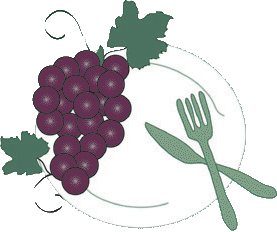
In the grassy plain of the Po, between Piacenza and Bologna, a quarter million grass-fed cows on 5,000 dairy farms contribute their milk to 500 artisanal producers of a very specific cheese, Italy's finest: Parmigiano - Reggiano.
In batches of 1,100 liters, the combined morning and afternoon milkings (the amount produced by some 40 bovines) is transformed: cream skimmed, casein starter and rennet added, curds cut into rice-sized granules, boiled for 10 minutes in a copper steam kettle under the watchful eye of a master craftsman, then drained, divided in two, wrapped in cheesecloth, formed in traditional, 100-lb. moulds, salted for three weeks, aged for a year, inspected and graded, then aged for another year or two. At the end of the process, the cheese emerges as genuine Parmigiano-Reggiano.
The best, stravecchio sells at the dairy for 13 euros a kilo, about $9 per pound. In restaurants here in Parma, the menu gives you the cheese's full pedigree: name of dairy, month of production. The real thing, when you can find it in the States, is around $15. And is it ever worth it. Dense, crumbly, it isn't sliced but stabbed into little pieces.
Nutty, fruity, sweet and despite the salt that helped create it, with a remarkable complexity and depth of flavor, it's a treat on its own (with a dash of balsamic vinegar, perhaps) or grated over pasta (nothing like the packaged soap flakes sold as "Parmesan" by Kraft). Here and only here: the product of its unique place, always hand-made.
A couple of easy recipes follow. Also, in days to come, the fabulous mosaics of Ravenna and the surprising Jewish history of Ferrara.
Baked eggs
Separate 4 eggs. Cook the whites in a skillet with 1 TB butter or olive oil until they're almost set, then slide in the yolks and cook a bit longer. Top with an ounce of shaved Parmigiano-Reggiano cheese and serve at once. (For an extra treat, add some truffle shavings as well.)
Parmigiano-Reggiano soufflé
Mix 3 ounces of flour with a bit of cold water and begin heating the mixture. Add 1 cup warm milk and continue heating, but don't let it boil. Stir in 3 ounces of aged Parmigiano-Reggiano and take off the heat. Separate 5 eggs and add the yolks, one by one, to the cheese mixture; season with salt and pepper. Whip the whites and gently fold them into the cheese mixture. Pour into a floured soufflé dish and bake in a 350-degree oven for about half an hour. Serves 2 as a main course, 4 as a side dish.
Don't thank me, thank those Italian cows.
Posted by Ronald Holden at December 3, 2006 9:15 AM

The International Kitchen
Cooking school vacations in Italy, France & Spain.


 Who links to me?
Who links to me?
Camera is in fact the new one, Sony cybershot DSC-W30, least expensive Sony--about $200--that takes real movies w sound. Though it's a 6.0 megapixel, I'm using the 3.0 megapixel setting ... and think I'll move it to an even lower resolution because it's tough to upload full-frame pix. (Work-around: I email them to myself with Picasa, which reduces them to about 1 megapixel...)
Posted by: Ronald at December 9, 2006 5:50 PMObee Ron Kanobi ~
Simply fabulous pictures! Are you using your new Sony, or the tried & true blue Nikon (circa 2000)?
Morgy
Posted by: Morgy at December 9, 2006 5:45 PMDavid's comment questioning amount of milk produced by one bovine (compared to one of his caprines) is accurate: would take some 50 cows to produce 1,100 liters of milk in one day, let alone 11,000 liters, as reported in the original (since corrected post). Point of reference: one moo, one day = 25 liters (6 to 7 gallons). Got it?
Posted by: Ronald at December 4, 2006 12:29 PMHi David, make cheese, that is...."Goat Cheese" LOL, but......that's another story for dear ol Ronald! PS: Thanks for the recipes Ron! Going to the kitchen now....Ciao!
Posted by: Lisa Hilderbrand at December 3, 2006 12:12 PM"In batches of 11,000 liters, the combined morning and afternoon milkings (the amount produced by some two dozen bovines)"
Wow. Sure like to know what sort of grass them thar bovine eat. Like to get me some fer my goats. But don't know that I'd be able to handle THAT much milk.
David